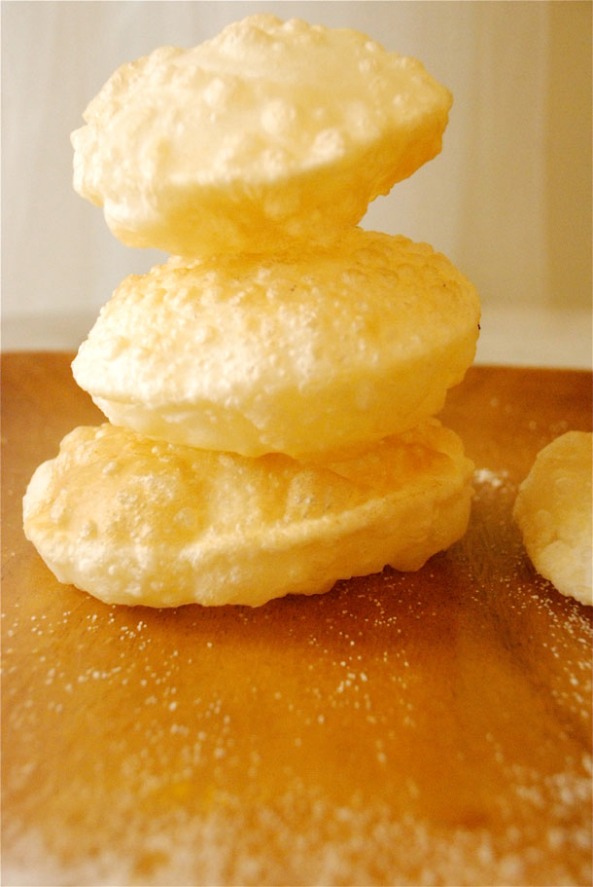
‘If Bruschetta remains Bruschetta and Crostata remains Crostata, then Phulko Luchi should be nothing else but be called Phulko Luchi!’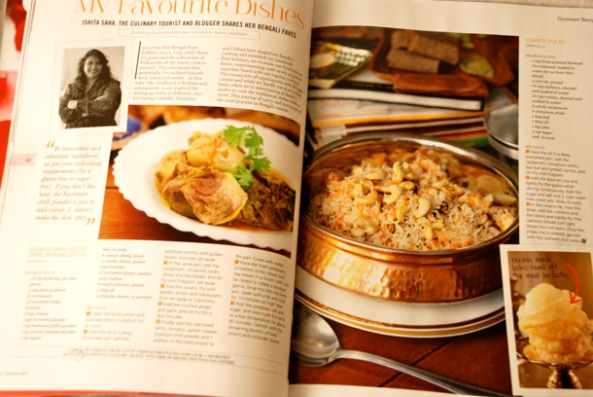
Luchi got featured in the February issue of Ahlan! Gourmet (above), along with Kosha Mangsho and Polao. Naturally, my Bengali foodie soul is very satisfied. When Olivia Spadavecchia, the Editor of Ahlan! Gourmet contacted me, I had already been planning to do a post – an Ode of the pictorial kind, on Luchi. I was slightly skeptical as to whether the Bengali names of the dishes should remain the same or was I going to translate and create names for them. What was I going to call Phulko Luchi? Puffed-up Flour Flatbread? Or, the Kasha Mangsho for that matter? Slow cooked Lamb, in the Bengali Style? I resorted to Twitter with a few Bengali blogger friends, a few of them having quite a lot of credibility internationally. A virtual ‘TweetAdda‘ (Adda is a common Bengali pass-time referring to plain, simple and pure Chit-chat, so TweetAdda refers to Adda on Twitter!) followed with @BongMomCookBook, @Finelychopped, @Soma_R (eCurry), @kankanasaxena (Sunshine & Smiles), @kaniskac (For the love of food) and @marginfades. 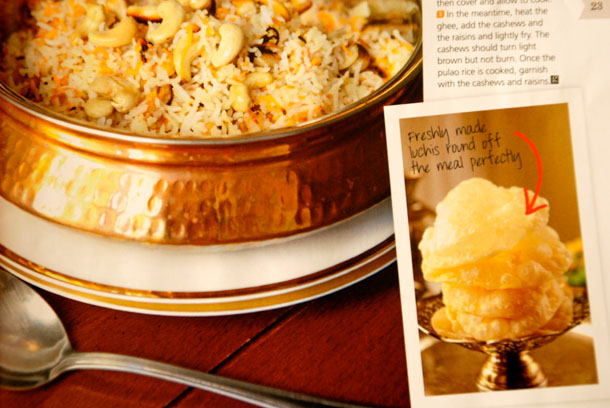
What follows below, are bits and pieces of our TweetAdda to highlight the dilemma a food blogger or a food writer who’s wanting to showcase a regional dish to those who are uninitiated to it. Does a dish lose it’s meaning and the very essence that’s associated with it, if the original name is not there or if it’s kind-of translated? Is everything lost in translation? And if at-all something can be captured in the translation, is it good enough? Do overlook the grammar, the punctuations and simply enjoy the pure essence of a discussion on Luchi.
What would be #KashaMangsho in English for international readers? Urgent!
Bong Mom’s Cookbook: Aiyyo don’t translate. Kasha Mangsho would be slow cooked spicy goat meat
For the love of food: just like you don’t translate chocolate
Margin Fades: add to that the word “dry” (dry slow cooked spicy goat meat). it’s helpful to have a description, even if it’s wordy
Sunshine and Smiles: i say, keep the original and explain the breakup detail in bracket. that’s how people should know the dish, by it’s original name!
eCurry: I do translate when I can in the title along with the original name
Me: I know that – your Patishapta translates into Crêpes with Sweet Coconut Cardamom Filling!!! #Lost in #translation??
eCurry: I feel everything is lost in translation 😦 do the best I can do. but it is crepe and it has that filling. LOL!
eCurry: the essence of the recipe is all lost in translation! too many words. like Kosha Mangsho says it all 🙂 but only for us
Can #Phulko Luchi be translated into Puffed-up Flour Flat-Breads?
Sunshine and Smiles: i think, fried puffed indian bread in brackets 🙂
@coffeemike joins in. I don’t know him (but will be following up on him, once the post is published). His tweets from a non-Bengali and a non-Indian perspective shows a different angle to the discussion.
@coffeemike: If I’m cooking another culture’s food, I’d like to know what it’s properly called
Me: Along with the explanations right? Mere translations won’t do, I presume!
Margin Fades: I would think so – can’t imagine leaving anyone to figure out Labongo Latika, for example
Me: that one will take some figuring out, honestly
Margin Fades: exactly! Labanga Latika, for example, is like a coconut turnover, pinned with cloves.
Me: Ivy Clove, perhaps?
Margin Fades: but as Ishita explains, it translates to Clove Ivy. (Which makes absolutely no sense.)
Ahhh, I got it Margin Fades, what a boost for my ego!

The final conclusion – if Bruschetta remains Bruschetta and Crostata remains Crostata, then Phulko Luchi should be nothing else but be called Phulko Luchi. As Kankana puts it ‘I feel we should never change the name or call it Indian something (for example – Samosas are not to be described as Indian Empanadas)… that’s how we can make these dishes famous, make people know the name as it should be. Adding an explanation in bracket would help people understand’. I am reminded of my conversation with MasterChef Sanjeev Kapoor. When I ask him why does Indian food mean either the North Indian food or the South Indian snacks and not any other regional Indian cuisine, he says – ‘It is the people from those region who have to take pride in their own food and come forward.’ Not to give up, I barge in – so there’s scope for a Bengali food blogger to come forward to the rescue? He answers – ‘Of-course, hundred percent!’
Interestingly, Olivia got back to me saying that she was more interested in Luchi than the Polao. In-fact, she wanted to capture Luchis in the making! I should have been surprised. Wow! She knows about Luchi? But it didn’t surprise me at all. I had already read about her in fellow Fooderati Blogger, Chef and Steward‘s I Work in Food series. I knew she was comfortable being in a kitchen, was adventurous and very much aware of the different cuisines of the world. Boasting of Italian roots, I’m presuming that her love and adventure for food can be perfectly complimented by a this Bong’s food passion. So here I am Olivia, taking pride in my Luchi and writing my ode on it, as I had promised! 

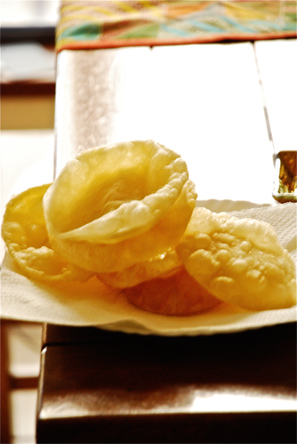
Luchi, the star, throws enough tantrums. As revealed by the Behind the Scene shots taken by me!
On the day of the shoot, as Shruti, the photographer puts the spotlight on Luchi, getting a shot of the perfectly Phulko Luchi or the perfectly puffed up Luchi becomes almost next to impossible. Many weeks back, I did manage to get my dream shot of Luchi at home – each Phulko Luchi perched on top of the other (the first cover picture in this post, much much above). But this was probably not a Star’s day for perfect-shots. By the time the Phulko Luchis were being scurried from the frying pan, across the kitchen counter and passed on to the table near the balcony door – possible the only place that gets a bit of decent sunlight, the Luchis were getting deflated. The beauty of Luchis is in its’ puffed up and swollen demeanor. That beauty fades completely once they become deflated (above right)! Finally, like a star who shines in front of only a good photographer, my Luchis did turn out looking great on fine-print.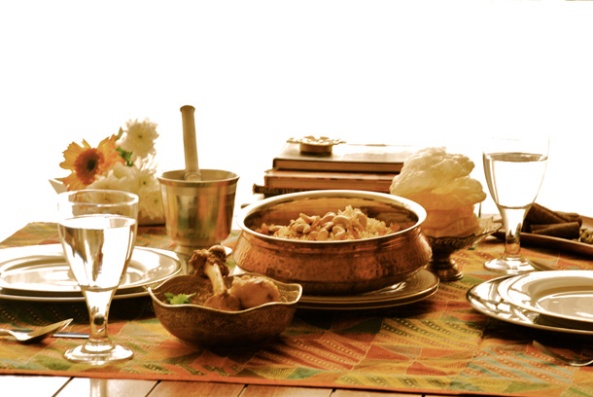
The table-setting as I had visualised… Coffee-table books on Kolkata and Art of Bengal, some traditional silver serving bowls, mortars, real whole spices along with wine glasses, contemporary crockery etc. And of-course with Luchi, Polao and Kasha Mangsho. 
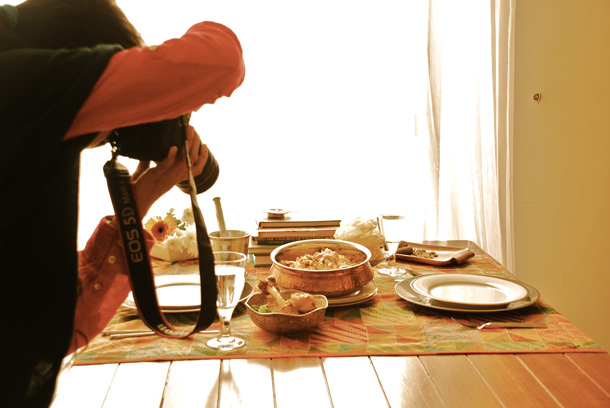
Phulko Luchi or Puffed Flour Flatbread
Category – Meal accompaniment; Cuisine type – Traditional Bengali
You may substitute the White Flour with Gluten-free Flour, but if Atta/Whole Wheat is used, then Luchi ceases to be the Bengali Luchi and turns into a non-Bengali Puris
Following are the characteristics of all recipes doling out of our little hands, big hearth –
♥ Easy to cook
♥ Regular canned products off the shelf may be used (However, we advocate using fresh products)
♥ Goes well both as a regular or party dish
♥ Children can easily help in making the dish (My two little sous-chéfs are aged 8 and 3 years!)
♥ And lastly, guaranteed to be tasty!
The best thing about making Luchis, is that, I can delegate the messy job of kneading to the Z-Sisters! Both Big Z and Li’l Z are thrilled everytime I outsource the job to them. 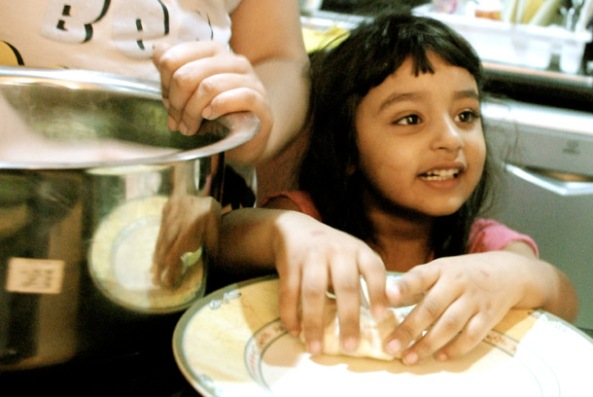
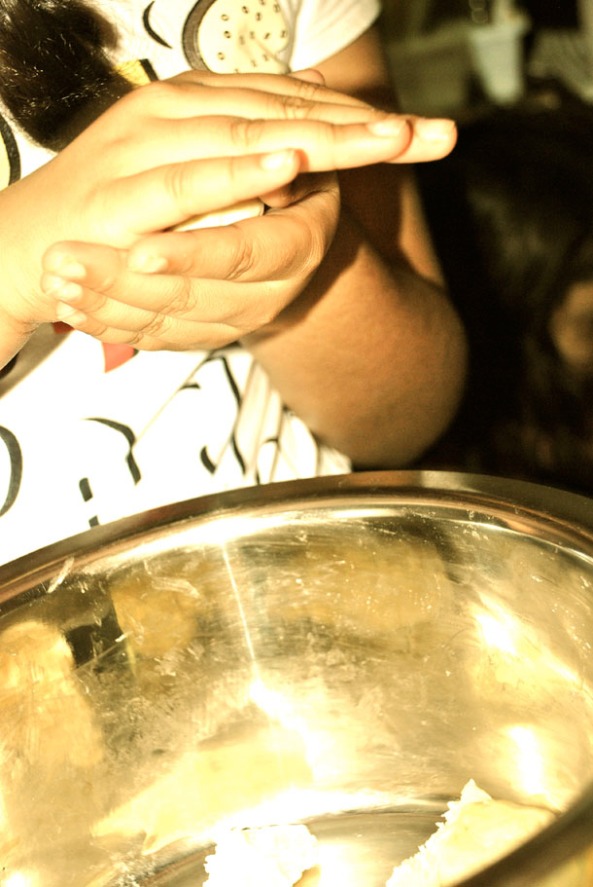

Makes 15 Luchis approximately
Ingredients
Flour – 1 cup
White Oil – 2 tbsp for the dough
White Oil – 2 cups for deep frying
Sugar – a pinch
Baking Soda – a pinch
Method of Preparation
Making the Dough
– The Dough should be kneaded into a smooth and soft ball
– Place it in a container and keep it covered for at-least 30 minutes
– Add the White Oil, Sugar, Baking Soda to the Flour and start kneading by sprinkling water very frequently
– The Dough should be kneaded into a smooth and soft ball
– Place it in a container and keep it covered for at-least 30 minutes
– Knead the Dough once again just before making the Luchi
– Pull out small amounts of Dough and make smooth, round balls in your palms (Each ball should be 1 inch in diameter)
– Flattened these balls by using a rolling-pin into circles of 4-5 inches in diameter (Perfect circles can be made by flattening the small balls and placing a sharp-edged round glass or bowl on top and cutting off the excess – that’s cheating but worth the aesthetic appeal!)
Frying the Luchi
– Heat the oil in a Wok (If the Oil is not very hot the Luchis won’t puff up. They will become crispy and flat
– Slide in each flattened flour into the hot oil and after a few seconds press it with your ladle. Immediately the Luchi should puff up. Turn it over and immediately take it off the oil (as shown in the pics below)
– Each Luchi has to be deep-fried separately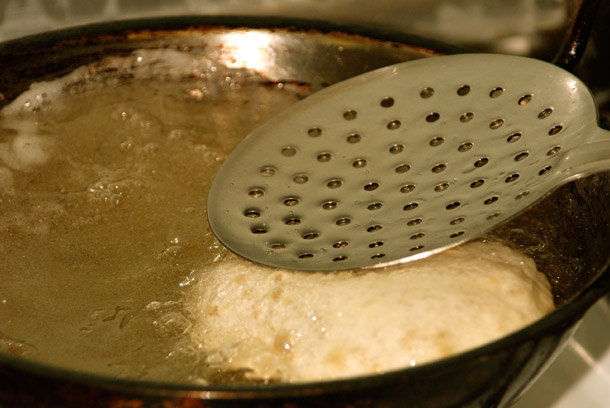

How do we serve Luchis?
Luchis are versatile. They can be served during Breakfast as well as for Main Meals. Depending upon whether one is having Luchi as a Snack or a Main meal, the accompaniment differs. Serve the Luchis hot. Take caution and don’t poke the puffed up Luchis with your finger immediately after they have been taken off the fire – the inside tends to remain extremely hot!
Famous Food Pairings that can be conjured up with Luchi
– Luchi and Begun Bhaja/Fried Eggplant
– Luchi and Aloo Bhaja/Fried Aloo
– Luchi and Aloor Dum/Potatoes- Luchi and Cholar Dal/Dal with Bengal Grams
– Luchi and Kasha Mangsho/Slow cooked Meat Bengali style (my post on a non-traditional Kasha Mangsho with red Wine!, while the traditional recipe is in the Blog queue!)
– Luchi and Payesh/Rice Pudding (my post on Notun Gurer Payesh /traditional Bengali Rice Pudding with Jaggery)
While the list goes on, here’s a pictorial journey to my ode on Luchi, from the very beginning. These photographs had already been taken long back and were lying in the IPhoto Albums, waiting for the day I would be making a post on Luchi. Thanks to Ahlan! Gourmet, my long-desired post got written!

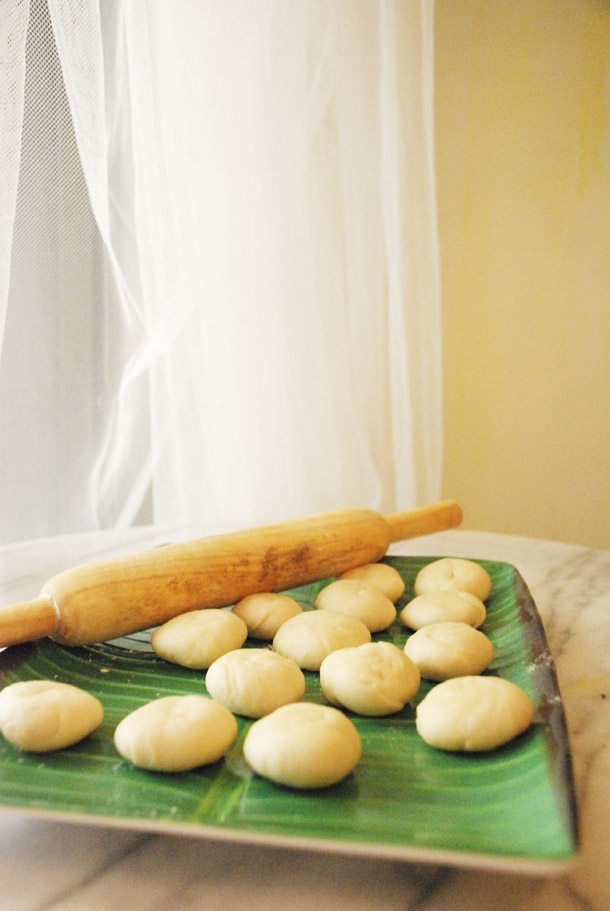
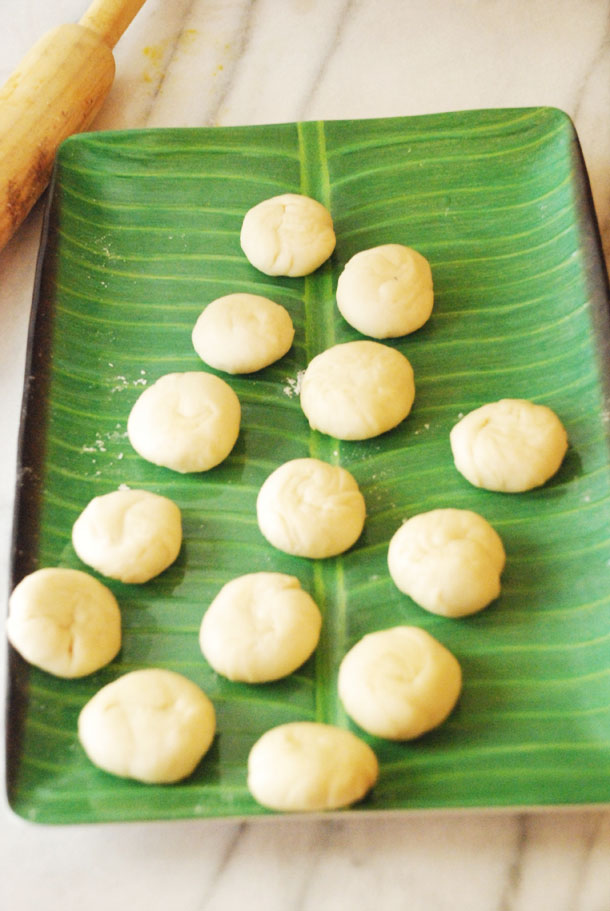
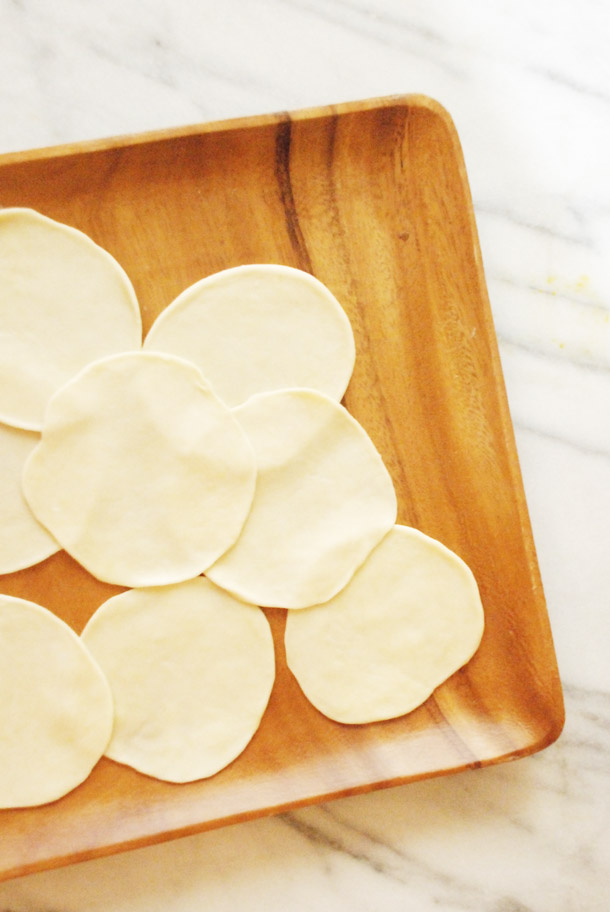

My Mum said ‘Jya! Luchi aar Kasha Mangsho ki emon khabar? Eto kichu banash, ekta onyo kichu korle partish!/Why Luchi and Kasha Mangsho? It’s such a regular dish. You cook so many things, couldn’t you have done something else?’ Precisely my point, Mama. It’s irregular for us and may just become extinct and not reach your grand-daughters’ plate, if a story is not written on it!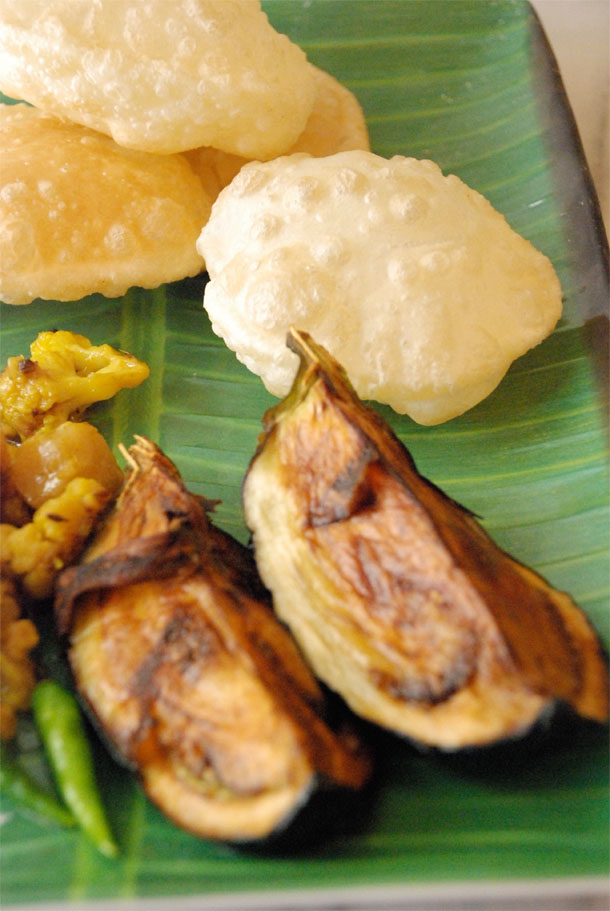
A post on Luchi would be incomplete without mentioning Indranimashi (below left). She’s been my parents’ friend for long. She has seen me since I was a child and has now, become a friend of mine as well. Having lived in Dubai for a decade, with parents living thousands of miles away, a few friends like Indranimashi, have become our unofficial guardians. No dinner in her place is complete without Luchi and every other traditional Bengali dish that go with it – Potol Bhaja, Begun Bhaja, Cholar Dal, Kasha Mangsho etc. The minimum amount of Luchis that she has to make for any party is 100. Her trusted Roti-maker (it flattens the dough balls) lends a very helping hand. Whenever I visit Indranimashi, I make sure that I also peep into her kitchen to say an inaudible Hello to the antique Roti-maker!
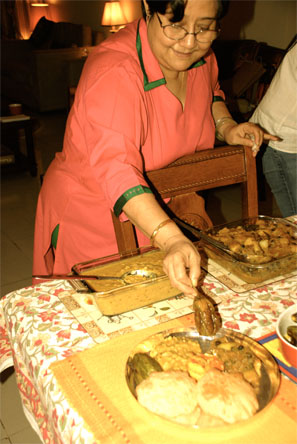
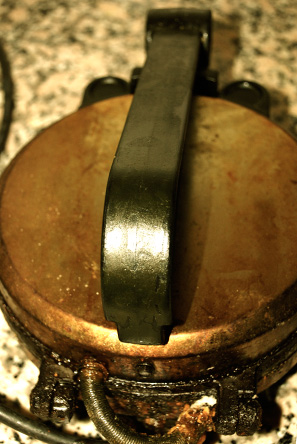
The article in Ahlan! Gourmet connected me to a lot of people – a lot of them are non-Bengalis but have had some connection to Kolkata at some point in time. Interestingly, a reader whose mother is a Bengali and father is from Hongkong, mailed me, addressing me as Ishitadi. He’s been to Kolkata, has seen Durga Puja and misses Luchi and Kasha Mangsho. Another British reader wrote to me, saying that he was posted in Kolkata, a long time back and is now living in Dubai. Would I be interested in teaching his kids to speak in Bengali and his wife to cook a few Bengali dishes! It’s interesting how Food gets us connected to strangers. It connects us with memories and nostalgia and people from across different regions. And it is while talking, writing about Food, sharing ideas on it and of-course while enjoying eating it, that we break down all our barriers!
Unblogging it all… Ishita
◊————————————————–◊
Disclaimer: Please do not use any material from this post. I hope you enjoy reading the posts with lots of visuals. While you enjoy seeing them, please don’t use them as some of them have been taken from our personal albums just to make your reading experience more pleasurable. You can see more pictures of my travel and food journey here.


I love your writing Ishita..very natural. and btw it was indeed a great opening shot of the star Luchi!
LikeLike
Thank you Swati. I’m glad that you liked reading it. And nice, isn’t it? Unfortunately, didn’t turn out like the opening shot on the day of the Ahlan! shoot!
LikeLike
AHLAN GOURMET…… AND A GOOD OLD LUCHI STORY….. WOW! ISH PISH! CONGRATS!
LikeLike
Thank you Kanaka. Love and good wishes from special people like you for sure:)
LikeLike
congrats on the article and yes it is important that we show the world that there there is much more to Indian food than tikka masalas…the luchis look scumptious…great read
LikeLike
Thanks Kalyan! Oh yes, I am at it – to shout out loud about regional cuisines. Enjoyed your Bong Bong outing in NDTV very much. You’ve been doing pretty much the same – congrats to you as well:)
LikeLike
This article is brilliant…besides giving luchis a special place in Ahlan…you have done a lot of research on luchis and you have helped me to learn so much more about this fantastic jolkhabaar or pujor prasad….cheers!
LikeLike
Thank you Indranimashi… this post is for all the Luchis that I’ve devoured at your place!!!
LikeLike
Nice post… But you always make me hungry…
LikeLike
Thank you Subhomita! If I make a food, click it, write about it to share with the world and if that doesn’t make you hungry, the why write? I’m glad that the posts make you hungry!
LikeLike
Pingback: International Women’s Day | May The Woman Be Celebrated Every Day, Everywhere! |
Pingback: Chef Sanjay Bahl | Flavours And Flavours And Flavours of Patiala! |
Pingback: Violet Oon | The Singaporean Food Guru & Her Recipe Of Chilli Crab! |
Pingback: Notun Gurer Payesh/Traditional Bengali Rice Pudding | Remembering My Dida |
Pingback: Colourful Kulfis | Celebrating The Colours Of Holi! |
Pingback: Shorshe Bata Maach – Mustard Salmon In This Case | A Detour From Thailand To Wish Shubho Noboborsho! |
Pingback: Ginger Lotus Sea Bass | Recipe From Blue Jade @RitzCarlton |
Pingback: Kolkata Biryani | Cooking The Royal Dish In Lafayette Gourmet And A Tweaked Recipe! |
Pingback: Kumro Bhaaté or Mashed Pumpkin Bengali Style And I Ask What The Heck Was Halloween? |
Pingback: Blog Turns 2 Years | A Very Special Giveaway! |
Pingback: Join Me For A Bengali Gourmet Meal On The 6th June | Book Munch |
Pingback: Join Me For A Bengali Gourmet Meal On The 4th June | Book Munch |
Pingback: How Did I Fare In Showcasing My Bengali Cuisine? |
Pingback: Opening Up My Bengali Kitchen For Dima Sharif | #RamadanSpecial2014 |
I will definitely give it a try soon 🙂
LikeLike
Any luck?
LikeLike
I made them this morning 🙂 Absolutely delicious, I added them on the side with grilled halloumi and honey. Thanks for sharing!!
LikeLike
What are you saying? Wow! Please please share the pic… Bengali luchi with Arabic Halloumi and honey – wow… I must must share this with my readers!!!!!
Ahhhhh moments when you pause and count your blog blessings!
LikeLike
I forgot to take a picture, but it was too tasty so I made them again! I uploaded a picture on my instagram 😀 I will also be posting them on my blog later this week!!
LikeLike
Oh Thank you… beautiful picture…. I saw it in instagram. Absolutely honoured:)
LikeLike
Ishita at last i found someone who knows about authentic food about Bengali Gourmet Shiraz in Bur Dubai has closed Where can I find similar Kolkatta food in Dubai or Sharjah. Indrani mashi took me down the lanes of Kolkatta to my childhood days. I live in Dubai where do you stay Are u in Kolkatta.
LikeLike
Thank you Shehnaz… I am glad that the post made you go down your memory lane. There is one small restaurant called Calcutta Fast Food in Sharjah, I have never gone there and eaten but have actually eaten their catered food at many Bengali houses – their maacher paturi is really good.
LikeLike
Pingback: Spicy Baby Potatoes or Aloor Dum – Kolkata Street Style! | IshitaUnblogged
After 33 response it will be a lil late in the day to comment however my dilemma on how to name a Kosha Mangsho is normal for any bengali food blogger . Nice article
LikeLike
Exactly, why this article was written… I struggle all the time. Think you should visit eCurry and Kankana’s Playful Kitchen.. they have a way to name their dishes, so that the international audience can understand.
LikeLike
Hope you have got your Kasha Mangsho in English:)
LikeLike
Another fantastic ode to the luchi !! Wonderful Ishita!
LikeLike
Thank you Devlina…. shorshe bata maach next?
LikeLike
Pingback: Abhijaan 2015 – Bengali Film Festival In Dubai | Teenkahon – Three Obsessions | IshitaUnblogged
Pingback: Abhijaan 2015 – Bengali Film Festival In Dubai | Manoj Michigan’s 89 | IshitaUnblogged
Pingback: Abhijaan 2015 – Bengali Film Festival In Dubai | Anindyo Ghosh’s Bharaate | IshitaUnblogged
Pingback: Abhijaan 2015 – Bengali Film Festival In Dubai | Atanu Ghosh’s ‘Ek Phali Rodh’ | IshitaUnblogged
Pingback: Payesh or Rice Pudding For My Birthday | Power of Gratitude Messages | IshitaUnblogged
Hi – thoroughly enjoyed the write up. I am curious if you have ever made luchi with gluten free flour? Do they really puff up? My non-Bengali husband discovered luchi about ten years ago, but he is gluten free as of four years now. I have managed to make gluten free naan and pita, but not luchi – yet 😦 Any suggestions? Thanks Bipasha
LikeLike
Pingback: Shubho Bijoya to all | Immersing in the bonding of love
Pingback: Shubho Noboborsho | A traditional Bengali menu for Frying Pan Diaries podcast
Pingback: Traditional Bengali Cuisine | All The ‘Slight’ Details
Pingback: A colourful weekend and Gajar Ka Halwa with Rabri Mousse and Shahi Tukda | IshitaUnblogged
Pingback: It’s time to reflect what I’ve been eating in our Chennai home – IshitaUnblogged